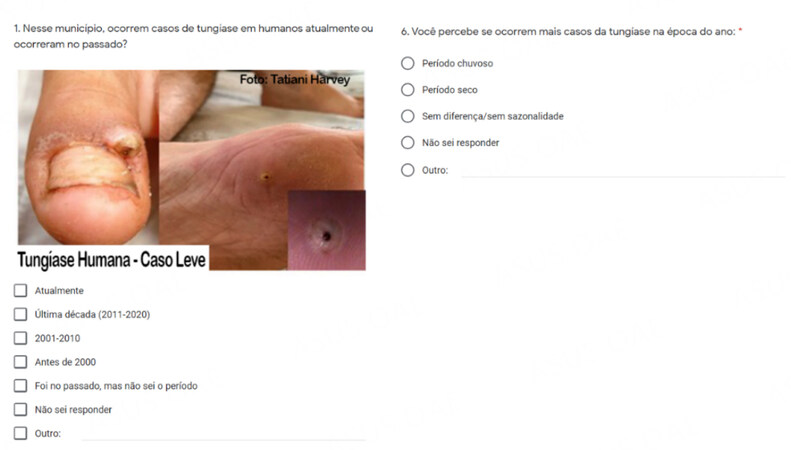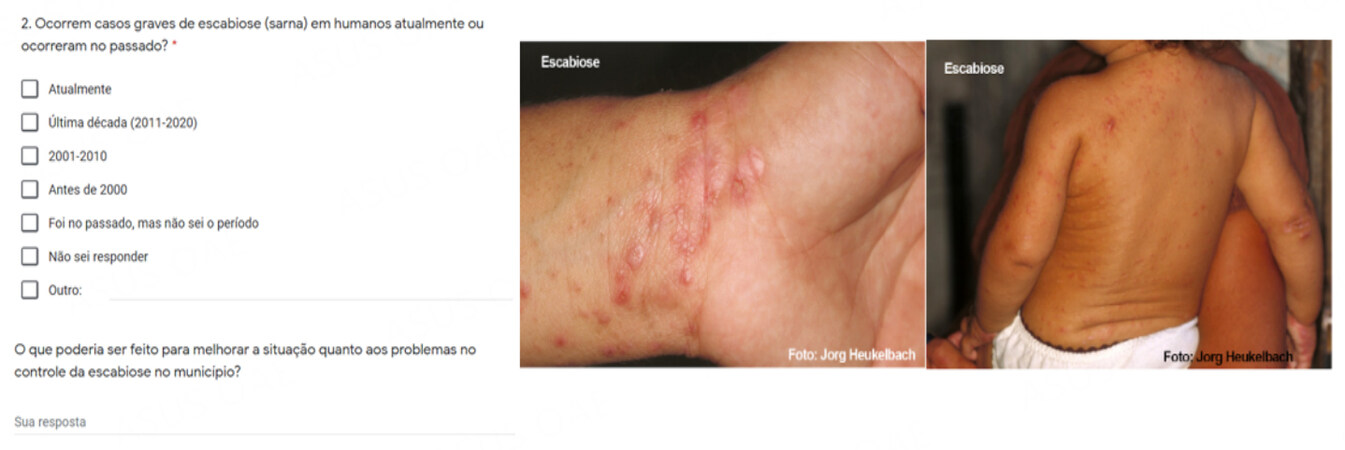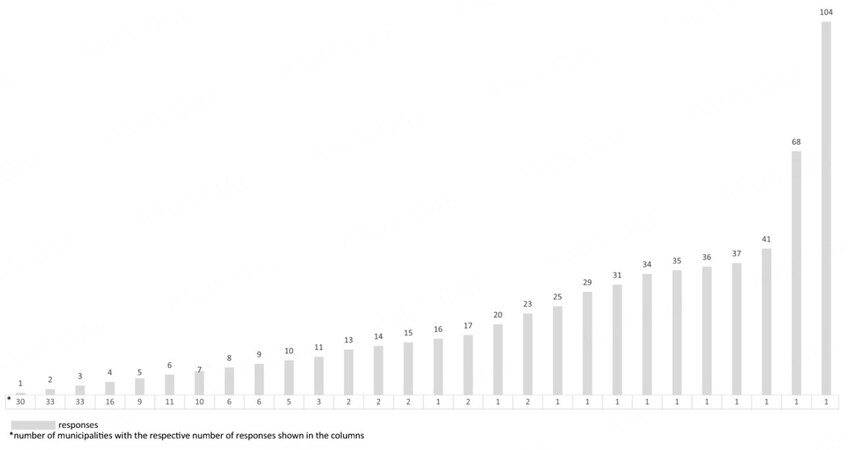A rapid assessment method to estimate the prevalence of ectoparasitoses in Brazil: tungiasis and scabies as case studies
Abstract
The epidemiologies of the ectoparasitoses tungiasis and scabies are unknown, and their distribution has not been described systematically in Brazil. We developed a rapid assessment method (RAM) based on an online questionnaire as a new tool to assess the prevalence of tungiasis and scabies and severe disease at the municipality level in the state of Ceará in northeast Brazil. As a first step, online records of tungiasis and scabies were collected from scientific publications, lay media, and the gray literature. Then, an image-based RAM with questions about the prevalence of these diseases, severe diseases, and animal reservoirs was developed as an online open questionnaire. Valid responses were obtained from 1265 respondents, primarily health professionals, from all 184 municipalities in the state. The literature review returned results for only two municipalities. The number of responses from the online questionnaires differed considerably between municipalities (one to 104 responses/municipality). Active contact with municipality health secretariats increased the number of respondents, especially community health agents. The RAM obtained consistent results regarding the prevalence and other epidemiological information. Our approach rapidly obtained primary data on the occurrence of these two important but neglected ectoparasitoses at the municipality level without considerable cost. This approach provides information for planning evidence-based control measures and identifying high-risk areas for focused studies. The RAM can easily be adapted and extended to other settings, countries, and diseases.
Keywords
INTRODUCTION
Ectoparasitoses such as tungiasis, scabies, and pediculosis are distributed worldwide but are neglected by the scientific community and health professionals[1]. Typically, ectoparasitoses occur in resource-poor communities with poor living conditions[2], and prevalences may be particularly high in vulnerable groups[3]. This group of diseases is associated with considerable morbidity and loss of quality of life[4]. Nevertheless, there is a paucity of systematic epidemiological data about the prevalence and incidence of severe disease[5], hindering the identification of high-risk areas and the development of evidence-based control measures. For sustainable control, a multidisciplinary One Health approach is essential, encompassing humans (and animals in the case of zoonotic diseases such as tungiasis) and the environment[6]. Studies have shown that sustainable control may be effective over a long period based on the One Health approach[7].
There is an urgent need to identify the geographic distribution of tungiasis and scabies in humans and animals, especially in endemic regions of Latin America and sub-Saharan Africa (and Asia and Oceania in the case of scabies). To design effective control measures, seasonal variation must be established across settings, the most critical animal reservoirs in each area must be identified, and high-risk areas should be defined.
Rapid assessment methods
The generation of evidence for disease control strategies needs to be fast, easy, and cost-effective to identify populations at risk and to understand the magnitude of diseases since economic and human resources are usually limited[8-10]. In this context, rapid assessment methods (RAMs) are efficient for collecting comprehensive information about a specific public health problem. They may focus on specific geographical areas and population groups, facilitating the planning, implementation, and monitoring of disease control programs[11].
Methods requiring field work and considerable human resources are difficult to apply on a more extensive geographical scale. Thus, new approaches such as geographic information systems and ecological niche modeling help map diseases’ geographic distribution and estimate the human population living at high risk. For example, a recent study in sub-Saharan Africa showed that approximately 668 million people living in 44 countries live in environmentally suitable areas of potential risk for tungiasis[12]. Another study using ecological niche modeling included socioeconomic and environmental data and information on disease occurrence from various sources (such as Ph.D. theses, master’s dissertations, scientific publications, and gray media) and identified 17 Latin American and Caribbean countries with potential risk for tungiasis, with 450 million people residing in this area[13]. Nevertheless, these methods are limited because they rely on published data, often unavailable for resource-poor settings.
Tungiasis and scabies as case studies
Tungiasis is an ectoparasitosis caused by the female sand flea Tunga penetrans[14] that causes erythema, itching, pain, and deformation of digits. Bacterial superinfection occurs in almost all patients[15-16]. The disease is endemic in marginalized urban and rural communities in sub-Saharan Africa, South America, and several Caribbean islands[17]. Reports from Ecuador and Peru showed that Tunga trimamillata might also cause tungiasis[18]. This species has not yet been described in human infestations in Brazil[19].
Scabies is an intensely itchy ectoparasitosis resulting from infestations with the mite Sarcoptes scabiei var. hominis[20]. Transmission occurs primarily through direct contact with infected persons but also via fomites[21]. Scabies lesions can occur on several body sites, and the topographic distribution varies by age[22]. It is one of the most common skin diseases and a public health problem in many resource-poor communities; hundreds of millions of people are affected worldwide[23]. Scabies and tungiasis are characterized by seasonal fluctuations of occurrence and severity, with peaks in the cold (scabies) and hot/dry seasons (tungiasis)[1].
In this paper, we describe the development and use of a questionnaire-based open online tool to identify the occurrence and severity of tungiasis and scabies at the municipality level in the state of Ceará in Brazil.
METHODS
Study area
Northeast Brazil presents favorable socio-environmental conditions for tungiasis and scabies. Several studies indicated that both diseases are present in the state of Ceará[15,24]; however, the prevalence is unknown. Ceará is divided into 184 municipalities, with an estimated population of 9.2 million and an area of 149,000 km². The state has an extensive Atlantic coastline, remains of an Atlantic rainforest, and some mountainous areas. There are 14 macroregions grouping the municipalities based on similar aspects linked to the geo-environmental, socioeconomic, and cultural characteristics of the municipalities[25]. The area is almost entirely characterized by a semiarid climate with irregular and scant rainfall[26]. The 184 municipalities were defined as observation units.
Approach
First, we performed an online bibliographic survey of national and international reference scientific literature, presentations at conferences and symposia, event proceedings, monographs, master’s dissertations, doctoral theses, lay media, and gray literature. Then, an open online questionnaire was created and pre-tested, and healthcare workers from municipalities were encouraged to complete the questionnaire.
Development of questionnaire
The online questionnaire was developed using the Google forms platform (https://docs.google.com/forms/d/e/1FAIpQLSfDSAlEjych01dfhRjiZPT32CSNO-RmNtdrm11RGy1HABPn9Q/viewform) [Figures 1 and 2] and pre-tested by a multidisciplinary professional team from several Brazilian states. The questionnaires included questions related to tungiasis and scabies, with a section for each disease with the same format of questions. The questions focused on the prevalence and severe disease, periods of occurrence (current or past cases), cases in animals, occurrence in indigenous and Afro-Brazilian communities, seasonality, the existence of control programs and possible hindrances to their executions, existence of related services (zoonoses control, health agents, veterinarians) that act specifically in the context of these diseases, and possible improvements in the municipality in the context of these diseases. No response field was mandatory, and there was space for free text comments.
Figure 1. Screenshot with examples of questions about tungiasis. Please see the appendix for a complete version in English.
Figure 2. Screenshot with examples of questions about scabies. Please see the appendix for a complete version in English.
A brief introduction about the research was made available at the beginning of the questionnaire, and some author photos were included for guidance. A Google questionnaire link was shortened to facilitate access
Data collection and measures to improve participation
Municipal health secretariats were contacted and requested to disseminate the online questionnaires via health professionals, focusing on community health agents (CHAs) who were encouraged to forward the link to their peers. This snowball system was used, which would allow a greater reach of participants. Other respondents also included nurses, nurse technicians, endemic disease agents, physicians, social workers, postgraduate students, speech therapists, and veterinarians. Data collection did not require fieldwork, which expedited the research process and reduced operational costs.
To contact each municipality’s professional teams, we initially relied on collaboration with the Federation of Community Health Workers of Ceará and later with the Syndicate of Health Workers of Ceará, which redirected the questionnaire link and provided contacts for direct access. In some cases, we contacted municipal coordinators of health teams and units, who contributed the questionnaire link. It is common for CHAs to have smartphones and internet access as part of their daily work practices, contributing substantially to increased participation. Data collection occurred over approximately seven months.
Data processing
First, questionnaire data from the Google platform were exported into Excel spreadsheets. We then analyzed the answers’ consistency and completeness to corroborate the outputs’ validity. These individual data were then grouped by the municipality, with each municipality as an observation unit. The variables were organized into categories and subcategories and coded for processing and statistical analysis.
RESULTS
The reference literature presented results on the prevalence of the diseases only in two major municipalities (Fortaleza and Cascavel). The lay media and gray literature returned results for only one municipality (Fortaleza, Figure 3). Up to 09/29/2021, the online questionnaires returned 1329 answers from all 184 municipalities of Ceará. Fifty-nine individuals answered more than once, and the municipality was not identified in five cases. Thus, these 64 data sets were excluded, and there were 1265 data sets finally. One municipality (Salitre) was visited by one of the authors. The respective CHA forwarded the link to his professional colleagues via Whatsapp messenger (snowball system). The visit to the Salitre municipality was necessary as it was impossible to contact any local health professional online or by phone. This is a relatively young municipality (33 years of existence), with few inhabitants and few health professionals. The ongoing COVID-19 vaccination campaign pulled away human resources in the health sector almost entirely in this area.
The median number of responses per municipality was three (interquartile range: two to seven), with a maximum of 104 responses. The number of responses by municipality is detailed in Figure 4. The highest number of responses was obtained from the municipality of Caucaia in the metropolitan region of Fortaleza (the state capital), with about 325,000 inhabitants. This finding resulted from direct contact with the primary care coordinator of the municipality, who encouraged the CHAs. Caucaia is the second most populous municipality in Ceará and has many CHAs to cover its various localities (a mountain range, expansive coastline, and extensive urban and rural areas). Municipalities on the coast generated more detailed answers, followed by those with better geographic access to the state capital and those from mountain range regions.
Table 1 details the individual characteristics of the respondents. There were more female than male respondents. Almost 1000 were CHAs, and approximately 10% of the respondents did not reveal their profession. Some respondents mentioned difficulties answering the online questionnaires, including fear of dealing with links in virtual environments, not having enough technological domain/digital education to open the link and answer the questions, and being very busy with the intensive vaccination campaigns against COVID-19. Some were ill with COVID-19 or mourning losing relatives and friends. These obstacles were managed by direct contact through messages or phone calls, emphasizing the importance of the study and the need for collaboration.
The professional background of respondents
| Respondents | Total n | Gender M/F |
| Community health agents (CHAs) | 982 | 113/869 |
| Nurses | 34 | 6/28 |
| Physicians | 14 | 7/7 |
| University professors | 6 | 3/3 |
| Postgraduate students in health | 5 | 1/4 |
| Civil servants | 5 | 1/4 |
| Endemic disease agents (EDA) | 4 | 2/2 |
| CHAs coordinators | 3 | 1/2 |
| Nursing technicians | 3 | 1/2 |
| Social workers | 3 | 0/3 |
| Area residents | 2 | 1/1 |
| Health unit coordinators | 2 | 0/2 |
| Municipal primary care coordinators | 2 | 0/2 |
| Secondary school teachers | 2 | 2/0 |
| Speech therapist | 1 | 0/1 |
| Veterinarian | 1 | 0/1 |
Many participants expressed the need for additional professional training on the topic, which was evidenced, for example, by relating diseases to sanitation and preventive vaccination campaigns. Table 2 details general comments made by the respondents, which indicate the need for training and the character of neglected tropical diseases.
General comments made by respondents to the survey
| Training |
| “We as community health agents need training in this regard” |
| “This issue should be addressed several times in courses for the CHAs and EDAs” |
| “They could give lectures and orientations about these cases in the communities” |
| “Do a training with the CHAs and the family health team” |
| “Give more professional recognition to the CHA so that he is able to collect and store this and other types of information” |
| “I would like to have more knowledge about these diseases” |
| “I would like the issue to be clarified for community health agents through the health department, so that when we are faced with such situations, we know how to handle them” |
| “I would like there to be more information about these diseases because the majority of the population doesn't see it as a disease, but as something common and simple” |
| “I am interested in participating in a course” |
| “You could provide us with training on the themes raised in the survey” |
| Public management/Control |
| “I only wish that the manager of our municipality would look more at the rural area in the case of health since we are deprived of a basic health team complete with professionals as soon as possible. Help the population as much as they need it and also against these cases of parasites in our region” |
| “A registry of the affected families” |
| “Inclusion of a project at the state level about tungiasis” |
| “It would be very good if the municipality had control over this” |
| “More programs about this kind of communicable diseases, like scabies and headlice. These diseases are completely forgotten by the authorities” |
| “The municipality should have actions in the prevention and promotion of the diseases mentioned in the survey” |
| Veterinary issues and vulnerable groups |
| “I would like that the families had quality housing, basic sanitation and that the municipality had a veterinary clinic so that we could take better care of our animals” |
| “We need programs directed to animals, especially with the street animals, because the only protection we have is from year to year with the vaccine. Many times we find animals in critical condition and we have no help” |
| “My suggestion is that if they do an active search for these diseases, they will find them mainly in people with low income, little education and people who don't have hygiene” |
| “We should have a better look at the low income class in relation to these problems” |
| “I would like to ask for animal control in the city” |
| “More care with the animals so that they are not passed on to other people. Mainly children, because they suffer more” |
| “The city where I live is on the beach, but there are all these cases cited, especially with animals. I suffer a lot with this, because there is no public agency that takes responsibility for this. It is cruel to see animals suffering and dying a little. This is very cruel” |
| General responses |
| “As a CHA, I don’t have information about the cases in the municipality, so I answered according to the micro area that I follow” |
| “I want to thank for the credibility and congratulate you for the initiative. CHAs and SUS hand in hand” |
| “I hope that this research will somehow have a positive impact on our municipality” |
| “Because they are sporadic, these events, perhaps, do not have an in-depth study to seek an investigation and a diagnosis to act as a whole” |
DISCUSSION AND CONCLUSIONS
We proposed an efficient RAM for state-wide estimation of the occurrence and severity of tungiasis and scabies at the municipal level. Data were available from all municipalities. This method enables the collection of data for identifying high-risk municipalities, which could be the focus of detailed studies and intensified control measures. Using spatial analyses, clusters among municipalities and regions can be identified. In line with previous approaches to estimating the occurrence of tungiasis using ecological niche modeling[12,13], data generated from the questionnaires provide a detailed evidence basis for endemic mapping areas. The literature-based review provided only limited information.
RAM has been developed for several neglected tropical diseases such as tungiasis[27], urinary schistosomiasis[8-10], onchocerciasis[28], lymphatic filariasis[29], and pediculosis[30], based on simple clinical examinations, self-diagnosis, signs and symptoms (such as macroscopic hematuria, palpable skin nodules, and presence of hydrocele), or application of questionnaires to patients or inhabitants. Our approach did not focus on the individual but aimed at collecting information on a larger scale. This approach facilitates identifying high-risk areas in the entire state; nevertheless, additional studies in the communities will be needed to assess the status of the diseases in detail.
The method is subject to limitations, as the response rates differed significantly between municipalities, and the generalization of the findings should be considered with caution. In areas with low endemicity, response rates will probably be lower. Partnerships with coordinators of primary health care and health units will considerably increase participation and response rates. Nevertheless, despite the COVID-19 crisis and the ongoing vaccination campaigns during data collection in many municipalities, the approach yielded robust results. The method does not provide details about the diseases at individual levels but at the municipality level as an observation unit.
In conclusion, the online questionnaire-based RAM is an effective tool for obtaining primary data on the occurrence and severity of tungiasis and scabies at the municipality level without any considerable cost. This approach provides rapid information for planning evidence-based control measures and identifying high-risk areas for planning in-depth studies. The RAM can easily be adapted and extended to other settings, countries, and diseases.
DECLARATIONS
AcknowledgmentsWe would wish to thank all professionals and people who answered the questionnaires, despite the high workload as a result of the covid-19 pandemic, and the Federation of Community Health Workers of Ceará (FESAC) and the Syndicate of Health Workers of Ceará (SINDISAÚDE) for collaboration.
Authors’ contributionsOriginal draft preparation: de Sousa Silva N, Heukelbach J
Performed data acquisition: de Sousa Silva N, Heukelbach J
Made substantial contributions to conception and design of the study and performed data analysis and interpretation, review and editing of the manuscript: de Sousa Silva N, Heukelbach J
Both authors have read and agreed to the published version of the manuscript.
Availability of data and materialsNot applicable.
Financial support and sponsorshipNone.
Conflicts of interestBoth authors declared that there are no conflicts of interest.
Ethical approval and consent to participateThe study complied with the National Health Council Resolution number 466 of October 12, 2012 and was approved by the Research Ethics Committee of the Federal University of Ceará (No. 4.919.773) of August 20, 2021.
Consent for publicationAll images were taken and produced by the authors, and the authors hold the copyright.
Copyright© The Author(s) 2023.
AppendixREFERENCES
1. Feldmeier H, Heukelbach J. Epidermal parasitic skin diseases: a neglected category of poverty-associated plagues. Bull World Health Organ 2009;87:152-9.
2. Amare HH, Lindtjorn B. Risk factors for scabies, tungiasis, and tinea infections among schoolchildren in southern Ethiopia: a cross-sectional Bayesian multilevel model. PLoS Negl Trop Dis 2021;15:e0009816.
4. Feldmeier H, Heukelbach J, Ugbomoiko US, et al. Tungiasis--a neglected disease with many challenges for global public health. PLoS Negl Trop Dis 2014;8:e3133.
5. Marks M, Sammut T, Cabral MG, et al. The prevalence of scabies, pyoderma and other communicable dermatoses in the Bijagos Archipelago, Guinea-Bissau. PLoS Negl Trop Dis 2019;13:e0007820.
6. Heukelbach J. One Health & Implementation Research: improving health for all. One Health Implement Res 2021;1:1-3.
7. Heukelbach J, Ariza L, Adegbola RQ, Ugbomoiko US. Sustainable control of tungiasis in rural Nigeria: a case for one health. One Health Implement Res 2021;1:4-13.
8. Mafe MA, von Stamm T, Utzinger J, N'Goran EK. Control of urinary schistosomiasis: an investigation into the effective use of questionnaires to identify high-risk communities and individuals in Niger State, Nigeria. Trop Med Int Health 2000;5:53-63.
9. French MD, Rollinson D, Basáñez MG, Mgeni AF, Khami IS, Stothard JR. School-based control of urinary schistosomiasis on Zanzibar, Tanzania: monitoring micro-haematuria with reagent strips as a rapid urological assessment. J Ped Urol 2007;3:364-68.
10. Ugbomoiko US, Dalumo V, Ariza L, et al. A simple approach improving the performance of urine reagent strips for rapid diagnosis of urinary schistosomiasis in Nigerian schoolchildren. Mem Inst Oswaldo Cruz 2009;104:456-61.
11. WHO. Rapid assessment and response adaptation guide for work with especially vulnerable young people. Available from: https://apps.who.int/iris/bitstream/handle/10665/339284/WHO-HIV-2004.15-eng.pdf [Last accessed on 3 Feb 2023].
12. Deka MA. Mapping the geographic distribution of tungiasis in sub-Saharan Africa. Trop Med Infect Dis 2020;5:122.
13. Deka MA, Heukelbach J. Distribution of tungiasis in Latin America: identification of areas for potential disease transmission using an ecological niche model. Lancet Reg Health-Am 2021;5:100080.
15. Feldmeier H, Eisele M, Sabóia-Moura RC, Heukelbach J. Severe tungiasis in underprivileged communities: case series from Brazil. Emerg Infect Dis 2003;9:949-55.
16. Feldmeier H, Heukelbach J, Eisele M, Sousa AQ, Barbosa LM, Carvalho CB. Bacterial superinfection in human tungiasis. Trop Med Int Health 2002;7:559-64.
17. Heukelbach J, de Oliveira FA, Hesse G, Feldmeier H. Tungiasis: a neglected health problem of poor communities. Trop Med Int Health 2001;6:267-72.
18. Linardi PM, De Avelar DM, Filho EJ. Establishment of
19. Marcondes CB. Doenças transmitidas e causadas por artrópodes. São Paulo; Atheneu; 2009. pp. 557
20. Heukelbach J, Walton SF, Feldmeier H. Ectoparasitic infestations. Curr Infect Dis Rep 2005;7:373-80.
22. Jackson A, Heukelbach J, Filho AF, Júnior Ede B, Feldmeier H. Clinical features and associated morbidity of scabies in a rural community in Alagoas, Brazil. Trop Med Int Health 2007;12:493-502.
23. El-Moamly AA. Scabies as a part of the World Health Organization roadmap for neglected tropical diseases 2021-2030: what we know and what we need to do for global control. Trop Med Health 2021;49:64.
24. Heukelbach J, Winter B, Wilcke T, et al. Selective mass treatment with ivermectin to control intestinal helminthiases and parasitic skin diseases in a severely affected population. Bull World Health Organ 2004;82:563-71.
25. Instituto de Pesquisa e Estratégia Econômica do Ceará (IPECE). Ceará em números 2020. Available from: https://www.ipece.ce.gov.br/ceara-em-numeros [Last accessed on 3 Feb 2023].
26. Silva NS, Alves JMB, Silva EM. Avaliação da relação entre a climatologia, as condições sanitárias (lixo) e a ocorrência de arboviroses (dengue e chikungunya) em Quixadá-CE no período entre 2016 e 2019. Rev Bras Met 2020;35:485-92.
27. Ariza L, Wilcke T, Jackson A, et al. A simple method for rapid community assessment of tungiasis. Trop Med Int Health 2010;15:856-64.
28. Kipp W, Bamhuhiiga J. Validity of nodule palpation in a Simulium neavei-transmitted onchocerciasis area in Uganda. Am J Trop Med Hyg 2002;67:128-31.
29. Weerasooriya MV, Isogai Y, Itoh M, et al. Distribution of filarial elephantiasis and hydrocele in Matara district, Sri Lanka, as reported by local leaders, and an immunological survey in areas with relatively high clinical rates. Parasitol Int 2008;57:390-5.
Cite This Article
Export citation file: BibTeX | RIS
OAE Style
Heukelbach J, de Sousa Silva N. A rapid assessment method to estimate the prevalence of ectoparasitoses in Brazil: tungiasis and scabies as case studies. One Health Implement Res 2023;3:1-10. http://dx.doi.org/10.20517/ohir.2022.26
AMA Style
Heukelbach J, de Sousa Silva N. A rapid assessment method to estimate the prevalence of ectoparasitoses in Brazil: tungiasis and scabies as case studies. One Health & Implementation Research. 2023; 3(1): 1-10. http://dx.doi.org/10.20517/ohir.2022.26
Chicago/Turabian Style
Heukelbach, Jorg, Nathiel de Sousa Silva. 2023. "A rapid assessment method to estimate the prevalence of ectoparasitoses in Brazil: tungiasis and scabies as case studies" One Health & Implementation Research. 3, no.1: 1-10. http://dx.doi.org/10.20517/ohir.2022.26
ACS Style
Heukelbach, J.; de Sousa Silva N. A rapid assessment method to estimate the prevalence of ectoparasitoses in Brazil: tungiasis and scabies as case studies. One. Health Implement. Res. 2023, 3, 1-10. http://dx.doi.org/10.20517/ohir.2022.26
About This Article
Copyright
Data & Comments
Data
 Cite This Article 15 clicks
Cite This Article 15 clicks















Comments
Comments must be written in English. Spam, offensive content, impersonation, and private information will not be permitted. If any comment is reported and identified as inappropriate content by OAE staff, the comment will be removed without notice. If you have any queries or need any help, please contact us at support@oaepublish.com.